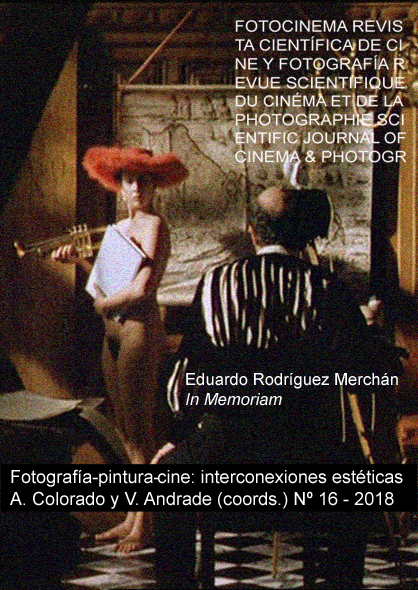Symbiotic relationship between painting and cinema in matte painting
DOI:
https://doi.org/10.24310/Fotocinema.2018.v0i16.4089Keywords:
Matte painting, painting, cinema, interrelations, synergy, symbiosAbstract
In this paper we want to focus on a particular resource of the cinematographic construction, matte painting, a special effect that very few times has received sufficient attention by theoretical investigations but which nevertheless appears as a particularly suggestive subject in which the synergy between the pictorial and the film is used for the elaboration of a hybrid image resulting from the symbiotic collaboration between both media. Throughout this article we will see how in a shot with matte painting we can find a complex dialogue between painting and cinema, a relationship of mutual contributions where painting contributes incorporating everything that the camera fails to portray and film provides a certificate of reality to the painted image. And it will be in this context where we find one of the most intimate, if not the most intimate, relationships of those established between cinema and painting.
Downloads
Metrics
Publication Facts
Reviewer profiles N/A
Author statements
Indexed in
-
—
- Academic society
- N/A
- Publisher
- Universidad de Málaga
References
Aumont, J. (1997). El ojo interminable. Barcelona: Paidós.
Bazin, A. (2008). ¿Qué es el cine? Madrid: Rialp.
Borau, J. L. (2003). La pintura en el cine. El cine en la pintura. Madrid: Ocho y Medio.
Cerrato, R. (2010). Cine y Pintura. Madrid: Ediciones JC.
Darley, A. (2002). Cultura visual digital. Espectáculo y nuevos géneros en los medios de comunicación. Barcelona: Paidós.
Deleuze, G. (1984). La imagen-movimiento. Barcelona: Paidós.
Dubois, P. (1994). El acto fotográfico. Barcelona: Paidós.
Eisenstein, S. (1989). Teoría y técnica cinematográficas. Madrid: Rialp.
Manovich, L. (2005). El lenguaje de los nuevos medios de comunicación. La imagen en la era digital. Barcelona: Paidós Ibérica.
Metz, C. (2002). Ensayos sobre la significación en el cine (1968-1968). Barcelona: Paidós.
Mitry, J. (2002). Estética y psicología del cine. Las estructuras. Madrid: Siglo Veintiuno de España Editores.
Vaz, M. C. & Barron, C. (2002). The invisible art. San Francisco: Chronicle Books.
Zunzunegui, S. (2010). Pensar la imagen. Madrid: Cátedra. Signo e Imagen. Universidad del Pais Vasco.
Downloads
Published
How to Cite
Issue
Section
License
All contents published in Fotocinema Revista científica de cine y fotografía are protected under the Creative Commons Attribution-NonCommercial-ShareAlike 4.0 International (CC BY-NC-SA 4.0) license. All about this license is available in the following link: <http://creativecommons.org/licenses/by-nc-sa/4.0>
Users can copy, use, redistribute, share and exhibit publicly as long as:
- The original source and authorship of the material are cited (Journal, Publisher and URL of the work).
- It is not used for comercial purposes.
- The existence of the license and its especifications are mentioned.
There are two sets of authors’ rights: moral and property rights. Moral rights are perpetual prerogatives, unrenounceable, not-transferable, unalienable, imprescriptible and inembargable. According to authors’ rights legislation, Fotocinema. Revista científica de cine y fotografía recognizes and respects authors moral rights, as well as the ownership of property rights, which will be transferred to University of Malaga in open access. The property rights are referred to the benefits that are gained by the use or the dissemination of works. Fotocinema. Revista científica de cine y fotografía is published in an open access form and it is exclusively licenced by any means for doing or authorising distribution, dissemination, reproduction, , adaptation, translation or arrangement of works.
Authors are responsable for obtaining the necessary permission to use copyrighted images.














13.png)



